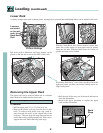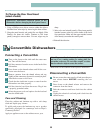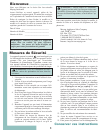
10
Food Soil Remains
On Dishes
Glasses Are
Cloudy/Spotted
Items Washed in the
Dishwasher or the
Dishwasher Tub
Itself are Stained/
Discolored
Items Not Properly
Dried/Moisture is
present on the
dishwasher interior
after the dry cycle.
Dishware is Chipped
• Check water temperature. (pg. 4)
• Run hot water at the sink before starting the dishwasher.
• Select Temp Boost, AccuTemp
™
, or Extended Wash
(select models)
.
• Check water hardness and adjust detergent amount accordingly. (pg. 4)
• Use fresh detergent stored in a cool dry place.
• Select proper cycle for the soil level.
• Load items so they do not block the wash arms or center tower. (pgs. 2-3)
• Load the utensil basket with some handles up and some down to prevent nesting.
• Do not load glasses over tines.
• Prior to loading, scrape off burnt on foods and wipe the starchy film from utensils used with
pasta, rice and oatmeal. These soils require more energy than the rest of the load to clean.
• Always use a rinse aid.
• Check water temperature, incoming water should be 120-140º F (49-60° C).
• Confirm that the cloudiness is removable by soaking the item in white vinegar for approx-
imately 5 minutes. If removed, the problem is due to hard water. Adjust detergent amount
being used to match water hardness (pg. 4). Be sure detergent is fresh, stored properly and
is a high quality brand.
• If cloudiness is not removable, it is
etching. This is an erosion of the surface of the glassware
and can be caused by water that is too hot, from using too much detergent or by prewashing
(the detergent needs food soil to act upon). If etching has occurred, the glassware is perma-
nently damaged. To prevent further etching, adjust the detergent amount to match the water
hardness, stop prewashing, and be sure incoming water is not greater than 140° F (60° C).
Use water heating options only when incoming water temperature is below120° F (49° C).
• Aluminum utensils or pans can leave marks when they rub against other items. Leave a
slight space between items.
• Iron in the water can leave a yellow, brown or orange film on dishes or the dishwasher tub.
A filter may be needed, check with a water treatment company. RoVer Rust Remover**
can be used to remove rust. Do not use RoVer along with dishwasher detergent. Fill both
detergent cups with RoVer and complete a Normal Wash cycle. Follow with a short wash
cycle using dishwasher detergent.
• Color from tomato based products may adhere to the tub (pg. 7). If light staining has occurred,
leave the door open to oxidize the stain away. For removal of heavier stains, try a citric acid
containing dishwasher cleaning product such as Glisten**. Change dishwasher detergent and
be sure to use a dishwasher detergent that contains chlorine for better stain fighting.
• Be sure Heated Dry is selected.
• Water droplets may form on the inner door as part of the drying process.
• Always use a rinse aid like Jet Dry* or Cascade Rinse Aid*.
• Check water temperature. (pg. 4)
• Select Temp Boost, Sani Heat, and/or AccuTemp
™
(select models)
.
• Increase detergent amount to match water hardness. (pg. 4)
• Load properly. (pgs. 2-3)
• Plastic and teflon items are difficult to dry because the porous surface tends to collect
water droplets. Towel drying may be necessary.
• Glasses and cups with concave bottoms can hold water and may require towel drying.
• Load dishes according to instructions so they do not strike each other. (pgs. 2-3)
• Washing antique china/crystal in the dishwasher is not recommended.
• Do not load glasses over the tines.
• Do not overload.
* Brand names are trademarks of the respective manufacturer.
**RoVer Rust Remover part number 057961
Glisten part number 18001017
To order call 1-800-688-8408


















